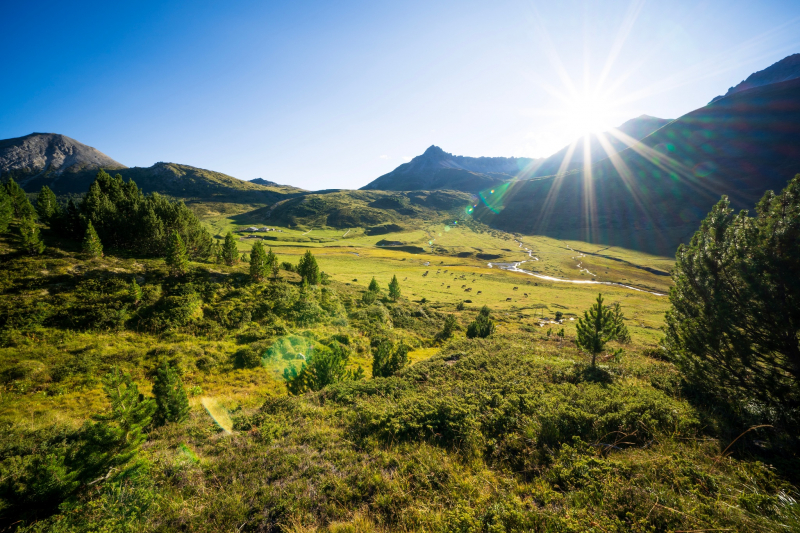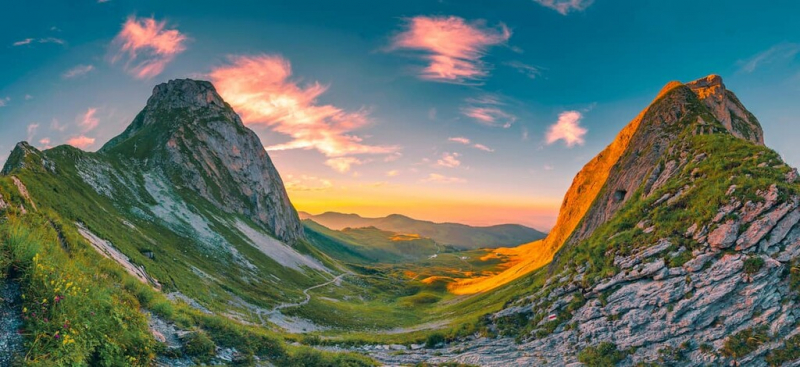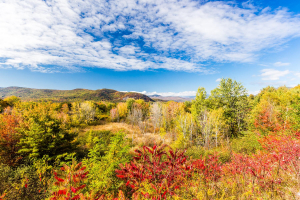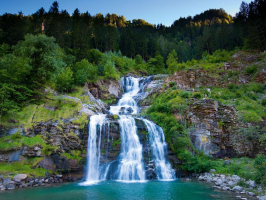Top 10 Most Beautiful Forests in Switzerland
The whole of Switzerland used to be covered with untouched primeval forest from Lake Geneva to Lake Constance. Now, only a few pockets of primeval forest ... read more...remain. However, those forests are wonderful, majestic, and contain many interesting things. Let's join Toplist to discover the Most Beautiful Forests in Switzerland - an interesting destination for tourists.
-
Sihlwald Forest, located just 10 kilometers south of Zurich's vibrant city center, is one of the most primitive and beautiful forests on the Swiss plateau. It is the Swiss plateau's largest contiguous mixed forest. For centuries, the forest provided firewood for Zurich, but no trees have been felled since the year 2000. Today, anyone walking through the woods will come across massive ancient trees and gnarly deadwood.
Sihlwald was originally an 1100 ha beech forest in the heart of Zurich-Zug-Lucerne. Natural processes have been protected, allowing Sihlwald to become overgrown, resulting in a natural forest that provides habitat and nourishment to numerous plants and wildlife - as well as a unique wilderness experience for humans. There are 72 kilometers of footpaths, 58 kilometers of cycle routes, and 54 kilometers of bridle paths just waiting to be discovered. Allow yourself to be enchanted by a stroll through the Wildnispark Zurich Sihlwald, with its 200-year-old giant trees and commanding views from the Albis-Hochwacht observation tower.
Location: Zurich Wilderness Park Sihlwald, Switzerland
via: Zurich Tourism 
via: Wikimedia Commons -
The Valle di Lodano is home to a large forest reserve with fascinating landscapes, abundant flora and fauna, and evidence of past human activity. A large interdisciplinary project with a holistic approach restored and enhanced these elements. Several landscape improvements were made as a result of the project, as well as historical and scientific research. The Valle di Lodano has old beech forests, which are a vast forest reserve set in a fascinating landscape with numerous natural elements and evidence of past human activities.
The Valle di Lodano has dense forest up to higher elevations, where alpine pastures can be seen despite rapid vegetation growth. The forests of Valle di Lodano are diverse due to their heterogeneous morphology. The lower hill belt is dominated by chestnut groves and pioneer birch forests, and the mild climate in gorges and screes supports small-leaved lime trees, while oak trees thrive in the most exposed and arid areas. The montane belt is dominated by beech; especially on the valley's left side, there are almost pure beech woods with mature specimens; on the opposite shadier side, the beech is mingled with silver fir, which is increasing in number after years of intensive logging. The subalpine belt is dominated by larch, although below Alp da Canaa and around Alp da Nagairón Norway spruce is also present.
Location: Ticino, Switzerland
via: Outdooractive 
via: Valle di Lodano -
At the far end of the idyllic Val S-charl, south of Scuol, lies the highest stone pine forest in Europe - The God da Tamangur. Romansch speakers view these forests as a symbol of tenacity, the will to survive and strength. The God da Tamangur has held protected status since 2007, allowing nature to develop and mature freely.
The God da Tamangur is at a height of 2300 meters. God da Tamangur Forest Nature Reserve covers an area of 86ha. Nature can flourish here; no more trees are felled, and those that die are left to rot. Individual trees grow extremely slowly up to an altitude of 2400 m and can thus live for up to 700 years. The only pine tree with five needles is the stone pine. Wandering through this fragrant forest past gnarled stone pines, some young and some hundreds of years old, is a once-in-a-lifetime opportunity to appreciate nature's wonders.
Location: Scuol, Graubünden, Switzerland
via: Outdooractive 
via: Outdooractive -
The Risoud forest is the largest forest in Europe with its 2'200 continuous hectares. Lining the western edge of the Vallée de Joux for approximately 15km, the Risoud forms a natural border between France and Switzerland. Its vast surface area, its density and its geographical situation have been a natural source and setting for numerous myths and legends.
The Risoud forest is primarily populated by spruce trees and is known for its resonance spruce trees of rare perfection, which are sought after by luthiers worldwide. Professionals believe that only one tree out of ten thousand has the necessary qualities to serve as tonewood. There are endless networks of walking paths to explore the calm of the Risoud and its many foresters' refuges. The Sentier du Mas des Grandes Roches discovery trail, which begins at the mountain refuge Apollo, is an excellent introduction to the fauna and flora of the Risoud forest.
Location: Vallée de Joux, Vaud, Switzerland
via: Vallée de Joux 
via: Région du Léman -
The Aletsch Forest, located directly next to the Alps' largest glacier, is a one-of-a-kind nature reserve that has been protected by Pro Natura since 1933. The affiliated nature reserve center is located on the Riederfurka in Villa Cassel (Riederalp). The Aletsch Forest is located on the southern lateral moraine of the Aletsch Glacier, the largest glacier in the Alps. Visitors on an altitude hike through the protected Aletsch Forest will be amazed not only by the trees, but also by the spectacular views of the glacier, Matterhorn, and surrounding mountains.
Stone pines dominate the landscape between 1,800m and 2,200m, with only a few larches, spruce, and beech trees interspersed. Stone pines are gnarled and extremely resilient trees that make up the majority of the trees in the Aletsch Arena's protected Aletsch Forest. They have successfully adapted to the harsh climate above the Great Aletsch Glacier. Some of these stone pines are up to 1,000 years old, making them Switzerland's oldest trees. The forest has many hiking trails that visitors are not permitted to deviate from.
Location: Fiescheralp, Valais, Switzerland
via: Fine Art America 
via: Flickr -
l'Arboretum du Vallon de l'Aubonne is a botanical collection of trees and shrubs from around the world. Located in the municipalities of Aubonne, Montherod, Bière and Saint-Livres, between 500m and 670m above sea level, it extends over 130 ha within an agricultural and forest site of around 200 ha. It is crossed by the Aubonne which, coming from the north, is joined by the Toleure, coming from the west.
The arboretum contains nearly 4,500 trees and shrubs from all of the world's temperate zones. They are classified by species and divided into copses based on their climatic and edaphic needs. There are reconstructions of forests in Japan and the northwest United States, among other places (ecotype of the states of Washington and Oregon). The arboretum also has a pomological section called "Orchards of Yesteryear", which features old fruit varieties as well as rose hips ("les Roses du Bois Guyot"). The varieties in the collection are visible in the Swiss National Database for Plant Genetic Resources Conservation. It pursues a recreational goal in addition to its scientific and educational missions. You can visit the various tree collections by following the marked circuits.
Location: Chem. de Plan 92, 1170 Aubonne, Switzerland

via: Wikipédia 
via: The Family of 5 Switzerland -
Over 170 square kilometres of pure alpine wilderness make up the Swiss National Park. It is the only national park in the country and wears the title well with over 80 kilometres of hiking trails and dedication to nature preservation. Along with its gorgeous scenery, the park is chock full of wildlife.
The Swiss National Park has evolved into a nature education center, bringing nature and the wilderness closer to those who are interested. Excursions, which emphasize personal experience, are an important component of this educational work. It is primarily a nature reserve with scientific objectives; no logging, grazing, flower picking, hunting, or fishing is permitted. Many rare Alpine plants grow in diverse vegetation. Ibex, chamois, red deer, foxes, martens, marmots, eagles, and other game birds are among the wildlife. The park is traversed by good roads from which foot trails branch out in all directions.
Location: the Western Rhaetian Alps, Switzerland
via: Viator 
via: Outdooractive -
The Gantrisch is a diverse nature park covering 402km2 located in the triangle formed by the cities of Bern, Fribourg, and Thun. Gantrisch Nature Park offers velvet hills, emerald forests, and colorful meadows, to name a few attractions. Get lost on the endless hiking trails or indulge in one of the 200 regional specialties. The nature park is famous for its starry sky, in addition to its local treats and numerous hiking trails. The night sky in Gantrisch is unlike any other because there is almost no light pollution.
There are wild animals in the area that can be seen when they emerge from hiding in search of food. Foresters also assist children in comprehending the small wonders of this mysterious world. The castles in Gürbetal, the baths in the Gurnigel region (old bathing culture), the St. James pilgrimage route with the Rüeggisberg Monastery, the Schwarzenburg Chapel, the churches in the various villages, the Grasburg, the farmhouses that are so typical of the area, or the bridges in the Sense and Schwarzwasser region are all cultural-historic objects of value in the Park.
Location: Schlossgasse 13, 3150 Schwarzenburg, Switzerland
via: cityseeker 
via: PeakVisor -
The Jura Vaudois Nature Park, which covers 531 square kilometers, brings together 35'800 people and thirty municipalities with a common goal. Spruce trees and dry-stone walls form a distinct landscape of wooded pastures here. They alternate with large forests, such as the Risoud, and reflect the region's silvopastoral activity.
There are nearly 217 alpine chalets scattered throughout the Park. They are sometimes used for tourist accommodation, but they are still dedicated to the alpine economy and cheese-making, as evidenced by the local specialties. This region, heir to a centuries-old history, vibrates with lively traditions and retains know-how such as fine watchmaking, woodworking, and wall builders' work. This nature preserves vital habitats for the capercaillie, peliad viper, and saxifrage goat. The presence of marshes, caves, and chasms reveals the Jura massif's karstic relief. Rivers are uncommon. Lakes, such as those in the Vallée de Joux, are even more valuable. Agriculture, services, and tourism are the mainstays of the local economy.
Location: Rte du Marchairuz 2, 1188 Saint-George, Switzerland
via: Outdooractive 
via: Morges Région Tourisme -
Few other regions have as many natural resources as the "Wild West of Lucerne". The Biosphere Reserve Entlebuch unfolds a mystical world, from pristine moorland landscapes to idyllic alpine meadows, over which the Schrattenfluh and Rothorn mountains tower majestically. The UNESCO Biosphere Entlebuch is a significant feature of the canton of Lucerne's south-western region.
Entlebuch is a UNESCO model region that represents the pre-alpine moor and karst landscape in the world's network of around 580 biosphere reserves. Entlebuch is the world's first biosphere reserve created through a local referendum. Moor landscapes of national significance cover more than a quarter of the area of the Biosphere Reserve Entlebuch. There is no other place in Switzerland with as much nationally protected moorland in such a small area as Entlebuch.
Location: Chlosterbüel 28, 6170 Schüpfheim, Switzerland

via: PeakVisor 
via: Flickr































